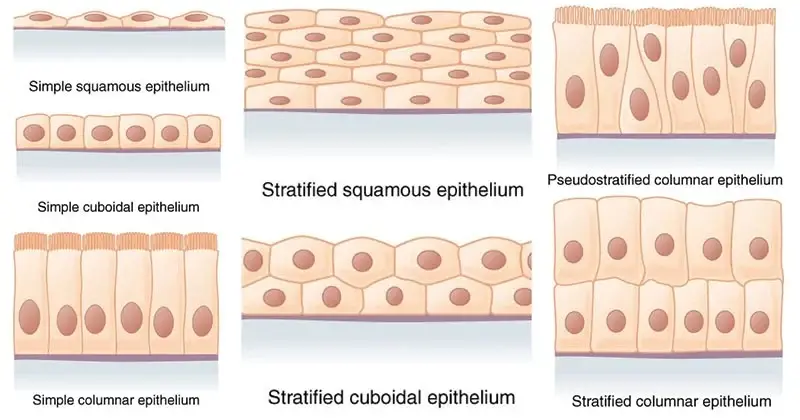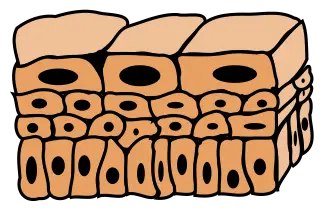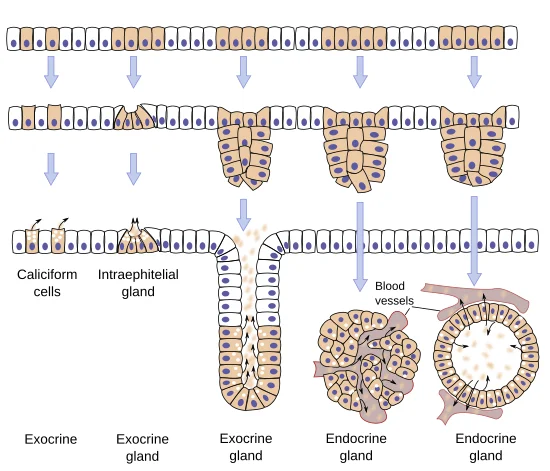Definition of Epithelial Tissue
Epithelial Tissue is one the types of tissues (epithelial muscular, connective and nerve) in mammals. It is composed of polyhedral cells that are tightly aggregated that adhere firmly to each other, forming sheets of cells that cover the inside of hollow organs as well as covering the body’s the surface. Epithelium, also known as epithelial tissue (plural epithelia) comprises cells that are laid out in continuous sheets, the form of single or multiple layers.
Characteristics of Epithelial Tissue
The epithelial tissue that is found in various parts of the body could differ in their structure and purpose, they all share the same characteristics. A few of these features are listed below:
1. Shape and Size
The epithelial tissue that is found in various parts of the body could differ in their structure and purpose, they all share the same characteristics. A few of these features are listed below:
2. Polarity
Epithelial cells are generally polarized that is characterized by membrane proteins and organelles dispersed in a different way inside the cell. The Apical (free) skin of the epithelial cells is located on the body’s surface or body cavity as well as the internal organ or gland duct which receives the secretions of cells. Apical surfaces could include microvilli or cilia. The sides of an epithelial cells, facing adjacent cells to the opposite side, could include intercellular adhesion as well as other junctions. The base of an epithelial cell binds to extracellular material like the basement membrane that can be described as an inert connective tissues created by epithelial cells.
3. Basement Membrane
The basement membrane an extracellular layer, which is composed of two layers: the basal lamina, as well as the lamina reticulare. The basal layer is close to the secretion of epithelial cells. It is a source of collagen and laminin, and proteins and glycoproteins. The reticular layer is more close to connective tissue beneath, and is a source of collagen protein that is produced by cells of connective tissues, also known as the fibroblasts.
4. Intercellular Adhesion and Other Junctions
A variety of membrane-associated structures facilitate cell adhesion as well as communication. Tight junctions, also known as zonulae-occludens, are the most apical junctions, which create a complete band that surrounds every cell. The other kind of junction is called the adherens junction, also known as zonula adherens. This is also enclosed by the epithelial cell generally just below it. The tight junction. Another type of anchoring junction is called the macula adherens, also known as the desmosome that are disc-shaped structures on the surface of a cell that match with similar structures found on the cell’s surface. Gap junctions facilitate intercellular communication, not adhesion or the occlusion of cells.
5. Avascular
The epithelial tissues are vascular, it relies on the blood vessels of adjacent connective tissue for nutrients and to eliminate the waste. The exchange of chemicals between epithelial and connective tissue is accomplished through diffusion.
6. Innervated
Epithelial tissue is internalized; that means the epithelial tissue has its own supply of nerves.
7. Renew and Repair
Epithelial cells exhibit an extremely high rate of cell division that allows the epithelial tissue’s ability to constantly regenerate and repair itself by eliminating damaged or dead cells in exchange for fresh cells.
Functions of Epithelial Tissue
Based on where it is located epithelial tissue plays many tasks. A few of them include:
1. Protection
One of the primary roles of epithelial tissue is protecting. It guards the cells below from radiation, desiccation and invasion by pathogens the effects of toxins or physical injuries. Blood vessels are not present within the epithelial tissue stops bleeding from the tissue in the event of abrasion.
2. Transportation
The epithelial tissue also plays a role in transporting different molecules inside and out of cells through different pumps that are present in the epithelial tissues. Apart from that, it is involved in the respiratory, digestive and urinary systems it facilitates the transfer of molecules between cells that are beneath them and the capillaries of the body and ducts.
3. Secretion
The epithelium of the gland releases different macromolecules, including hormones that are that are responsible for a variety of body functions. A number of glands (exocrine and endocrine) are also responsible for maintaining the body’s surface (skin) and help support the functions of various organs (digestive system).
4. Absorption
Because of the functions of specific structures such as cilia or microvilli on the surfaces of cell, the epithelial tissue assists in the absorption process of various molecules, by expanding areas of surface. In the digestive tract, the columnar cells in the small intestine assist to absorb water as well as numerous other nutrients.
5. Receptor function
The epithelial tissue are specifically designed to perform sensory functions . They detect sensory signals and convert it into neuronal signals. Epithelial tissues, such as the columnar epithelium that is pseudostratified of the olfactory mucosa have Apical cilia that permit the sense of the smell.
Types / Classification with examples and location
Epithelial tissue can be divided into two kinds:
- Covering and lining epithelium, also known as the surface epithelium that is the outer layer of skin as well as some internal organs. It also creates the lining for blood vessels and body cavities, ducts and the membrane of the digestive, respiratory, reproductive and urinary systems.
- Glandular epithelium which makes up glands’ secreting portions like the thyroid gland and sweat glands, adrenal glands, as well as digestive glands.
Additionally, the varieties of lining and covering epithelial tissues are classified based on how cells are arranged as well as the shape of these cells.

Simple epithelium
Simple epithelium is comprised of only one layers of cells that are identical that are typically found on absorptive and secretory surfaces. The single layer aids in the process of absorptive and secretory. Simple epithelium can be divided into three distinct types and their names are based on their shape and differ according to their roles.
a. Simple squamous epithelium
The epithelium that is squamous in its basic form consists of one layer of cells that looks like tiles on the floor when seen from the apical side. It has an apical nucleus located in the center which is flattened and an oval shape or even spherical. The epithelium is most often found in the lymphatic and cardiovascular system (heart lymphatic vessels, blood vessels) which is referred to as the endothelium. It also is the epithelial layer that forms part that is composed of membranes serous (peritoneum or pleura, pericardium) and is also known as. It can also be found in air sacs in the lung, the and in the glomerular (Bowman’s) capsules of kidneys, as well as the inside of the tympanic membrane (eardrum).
b. Simple cuboidal epithelium
Simple cuboidal epithelium is one layers of cells with cube shapes. They are round and possess the nucleus located in the center. It is a layer that covers the ovary’s surface and lines the anterior side of the capsule lenses of our eyes. It forms an epithelium with pigmentation on the posterior end of the retinas of the eyes, connects kidney tubules as well as smaller ducts from various glands, which are the an important gland’s secretory portion like thyroid glands and the ducts of certain glands like the pancreas.
c. Simple columnar epithelium
The columnar epithelium is formed by one layer of cells, which is rectangular in form, and surrounded by the basement membrane. The epithelium runs through various organs, and is frequently created to be designed for a specific purpose. The stomach is lined by columnar epithelium with no surface structures. But, the area of columnar epithelium which lines the small intestinal tract is wrapped in microvilli. They offer a large surface to allow the absorption of substances from small intestinal. In the trachea the columnar epithelium is ciliated. Additionally, it has goblet cells which secrete mucus. Also, in the tubes of the uterus, ova are pushed forward through ciliary action toward the uterus.
Stratified epithelium
The stratified epithelium comprises multiple layers of cells with various shapes. Basement membranes are typically absent. When basal cells divide, daughter cells that result from cell divisions are moved by older cells up towards the Apical layer. As they advance towards the surface, and away from the blood supply of connective tissue underneath They become less hydrated and less metabolically active.
These proteins dominate as the cytoplasm gets smaller and cells turn into solid, hard and eventually cease to exist. The apical layers are when dead cells shed cell junctions, they’re eliminated, but continue to be replaced when new cells arise from the basal cells. There are two major kinds of epithelium that are stratified such as stratified squamous and stratified cuboidal along with an epithelium that is stratified to the columnar level.
a. Stratified squamous epithelium
The epithelium with stratified squamous cells has several layers of cell. The cells that are located in the apical layer, as well as layers beneath it are squamous. The cells in the layers below vary between cuboidal and columnar.
i. Keratinized stratified squamous epithelium
The epithelium is formed by a layer of keratin that is located in the apical portion of cells and in layers that are a few layers deep it. The amount of keratin grows within cells when they withdraw from the blood supply with nutrients and organelles ultimately cease to function. Keratin is a durable and relatively waterproof layer that helps prevent drying out the cells that are beneath. Keratinized stratified squamous epithelium is the skin’s surface.
ii. Non-keratinized stratified squamous epithelium
The epithelium doesn’t contain huge amounts of keratin in the apical layers, and is layered several times deep. It is constantly moistened by mucous and salivary glands. The nonkeratinized stratified epithelium is found on wet areas (lining of the mouth and esophagus), a part of the epiglottis of the pharynx, as well as the vagina) and covers the tongue.
b. Stratified cuboidal epithelium
The stratified cuboidal epithelium is composed of multiple layers of cells, in which the topmost layer is composed of cuboidal cells. The deeper layer may be columnar or cuboidal. Cuboidal epithelium Stratified is visible in the salivary ducts that excretory sweat glands and salivary.
c. Stratified columnar epithelium
The epithelium with stratified columns has several layers of cells in which the top layer is composed of columnar cells. The more subordinate layer could be columnsar or cuboidal. This kind of epithelium can be found in the conjunctiva of the eyes, in parts of the urethra, as well as the tiny portion of the mucosa anal.
Pseudostratified columnar epithelium
The epithelium of pseudodostratified appears to have multiple layers as the nuclei of cells are found at different levels. Even though all cells are connected to the basement membrane as a single layer but some cells are unable to make it to the apical side. Because of these conditions it appears as an elongated tissue, but it actually is the epithelium itself. The epithelium is the line that connects epididymis to larger ducts of a variety of glands, as well as parts of the male urethra as well as airways in the majority of the upper respiratory tract.
Transitional epithelium tissue

Epithelium that is transitional (urothelium) is characterized by a variable look (transitional). When it is in a relaxed, or untretched state, it appears like cuboidal epithelium that has been stratified, with the exception that cells in the apical layer tend to be large and round. When tissue is stretched, cells shrink creating the appearance of stratified epithelium that is squamous. The multiple layers of elasticity and the underlying structure makes it suitable for filling with hollow organs (urinary bladder) that expand from the inside.
Glandular Epithelium
Epithelial cells that are primarily used to make and release diverse macromolecules could be found in epithelia along with other roles or include glands that are specialized organs. Splendid secretory cells, often known as unicellular glands, are found in simple cuboidal, basic columnar or pseudostratified epithelia. Glands are formed from epithelia that cover in the fetus via cell proliferation and expansion into connective tissue. They are then and then the development of further differentiation.

Endocrine glands
The endocrine glands’ secretions which are known as hormones, pass through the interstitial fluid, and move into the bloodstream, without passing through an artery. The effects of endocrine glands are vast since they are dispersed throughout the body via the bloodstream. The most prominent endocrine glands are the pituitary gland located at the brain’s base the pineal gland within the brain thyroid gland, parathyroid and thyroid glands in the in the larynx (voice box) and adrenal glands that are superior to kidneys, pancreas close to the stomach, the ovaries inside the pelvic cavity tests in the scrotum and the thymus in the thoracic cavity.
Exocrine glands
Exocrine glands release their products into ducts which let the secretions flow onto the surfaces of organs like the skin’s surface or the lumen of hollow organ. Effects of exocrine glands are only limited and some would have negative effects if they were to enter the bloodstream. Sweat, oil, the earwax glands on the skin digestive glands like salivary glands (secrete into the mouth cavities) along with the pancreas (secretes to the small intestine) are instances of exocrine glands.
- Text Highlighting: Select any text in the post content to highlight it
- Text Annotation: Select text and add comments with annotations
- Comment Management: Edit or delete your own comments
- Highlight Management: Remove your own highlights
How to use: Simply select any text in the post content above, and you'll see annotation options. Login here or create an account to get started.